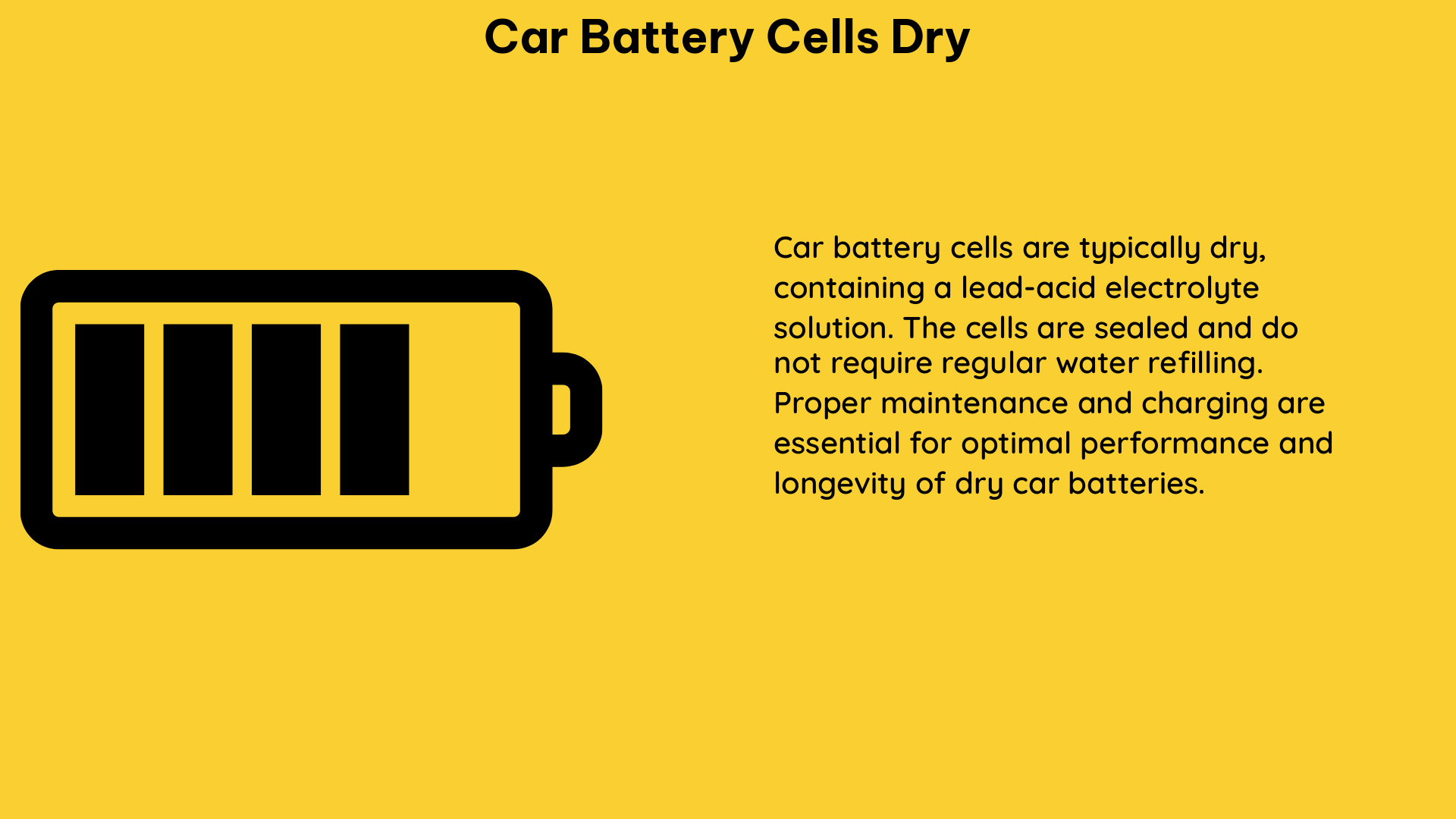Dry cell car batteries, also known as non-aqueous or maintenance-free batteries, offer several advantages over traditional wet cell batteries. They are sealed, valve-regulated units that contain an immobilized electrolyte, typically a gel or absorbed glass mat (AGM) material, which eliminates the need for regular water top-ups.
Understanding Dry Cell Battery Technology
Energy Density and Compact Design
One key aspect of dry cell batteries is their energy density, which refers to the amount of energy they can store per unit of volume or weight. A higher energy density allows these batteries to be more compact and lighter than their wet cell counterparts while still delivering the same or better performance.
According to a market report, the average energy density of dry cell car batteries ranges from 30 to 50 Wh/kg, compared to 20 to 40 Wh/kg for traditional wet cell batteries. This increased energy density can translate to a weight reduction of up to 30% for the same battery capacity.
Market Growth and Driving Factors
The global dry cell battery market is expected to grow at a CAGR of 7.5% from 2023 to 2030, driven by factors such as:
- Increasing demand for portable electronic devices: Dry cell batteries are widely used in smartphones, laptops, and other portable electronics due to their compact size and high energy density.
- Rising adoption of electric vehicles (EVs): Dry cell batteries, particularly lithium-ion and lithium-polymer variants, are becoming increasingly popular in EV applications due to their superior energy density and performance.
- Expanding renewable energy storage systems: Dry cell batteries, such as lead-acid and lithium-ion, are used in energy storage systems for renewable energy sources like solar and wind power.
Environmental Impact and Sustainability
In terms of environmental impact, dry cell batteries generally have a lower carbon footprint than wet cell batteries due to their sealed design, which reduces the risk of electrolyte leakage and subsequent soil and groundwater contamination.
According to a PDF document from the European Union’s Joint Research Centre, the carbon footprint of dry cell batteries can be up to 30% lower than that of wet cell batteries, depending on the specific battery chemistry and manufacturing processes.
Technical Specifications and Considerations

When selecting a dry cell car battery, it’s important to consider factors such as battery capacity, voltage, and CCA (cold cranking amps) ratings.
Battery Capacity and Voltage
A typical dry cell car battery might have a capacity of 40-100 Ah (ampere-hours) and a voltage of 12V. However, these specifications can vary depending on the battery’s size, intended application, and manufacturer.
For example, a compact car battery might have a capacity of 40-60 Ah, while a larger vehicle or heavy-duty application might require a battery with a capacity of 70-100 Ah.
Cold Cranking Amps (CCA) Rating
The CCA rating is a measure of a battery’s ability to deliver high current at low temperatures, which is crucial for starting an engine in cold weather. A typical dry cell car battery might have a CCA rating of 500-800 amps.
It’s important to match the CCA rating of the replacement battery to the original equipment manufacturer (OEM) specifications for your vehicle to ensure reliable cold-weather starting performance.
Proper Charging and Maintenance
To ensure optimal performance and longevity of dry cell batteries, it’s crucial to follow proper charging and maintenance procedures.
Charging Considerations
- Avoid deep discharges: Regularly discharging the battery to a low state of charge can shorten its lifespan.
- Use a suitable charger: Ensure that the charger is compatible with the battery’s chemistry and voltage requirements.
- Apply a gentle load: For new batteries, apply a gentle load (e.g., headlights) during the first five charge/discharge cycles to help condition the battery.
Maintenance Practices
- Keep the electrolyte level above the tops of the plates: This helps prevent plate exposure and premature degradation.
- Use distilled or deionized water for topping up: Tap water may contain minerals that can contaminate the electrolyte.
- Address acid stratification: If the battery dwells at low charge levels and never receives a full charge, acid stratification can occur, reducing the battery’s performance and lifespan.
By following these charging and maintenance guidelines, you can ensure optimal performance and longevity from your dry cell car battery.
Conclusion
Dry cell car batteries offer several advantages over traditional wet cell batteries, including higher energy density, lower environmental impact, and reduced maintenance requirements. By understanding the technical specifications and proper care procedures, you can ensure that your dry cell battery provides reliable and long-lasting performance for your vehicle.
References:
- Driving Towards Clarity: Analyzing the Dry Cell Battery Market. (2023, August 3). LinkedIn. https://www.linkedin.com/pulse/driving-towards-clarity-analyzing-dry-cell-battery-market/
- Rules for the calculation of the Carbon Footprint of Electric Vehicle Batteries. (2023, June). European Union’s Joint Research Centre. https://eplca.jrc.ec.europa.eu/permalink/battery/GRB-CBF_CarbonFootprintRules-EV_June_2023.pdf
- Acid Stratification and Surface Charge. (n.d.). Battery University. https://batteryuniversity.com/article/bu-804c-acid-stratification-and-surface-charge
- Battery Capacity and Voltage. (n.d.). Battery University. https://batteryuniversity.com/article/bu-201-how-to-determine-battery-capacity
- Cold Cranking Amps (CCA) Explained. (n.d.). Battery University. https://batteryuniversity.com/article/bu-903-how-to-measure-cranking-power

The lambdageeks.com Core SME Team is a group of experienced subject matter experts from diverse scientific and technical fields including Physics, Chemistry, Technology,Electronics & Electrical Engineering, Automotive, Mechanical Engineering. Our team collaborates to create high-quality, well-researched articles on a wide range of science and technology topics for the lambdageeks.com website.
All Our Senior SME are having more than 7 Years of experience in the respective fields . They are either Working Industry Professionals or assocaited With different Universities. Refer Our Authors Page to get to know About our Core SMEs.